Alopecia areata commonly known as spot baldness, is a condition in which hair is lost from some or all areas of the body. Often it results in a few bald spots on the scalp, each about the size of a coin. Alopecia areata is a disease that causes hair to fall out in small patches, which can remain unnoticeable. These patches may eventually connect and then become noticeable, however. This disease develops when the immune system attacks the hair follicles, resulting in hair loss. Sudden hair loss may occur on the scalp, and in some cases the eyebrows, eyelashes, and face, as well as other parts of the body. It can also develop slowly, and recur after years between instances. Hair loss can affect just your scalp or your entire body. It can be the result of heredity, hormonal changes, medical conditions or medications. Anyone can experience hair loss, but it’s more common in men.
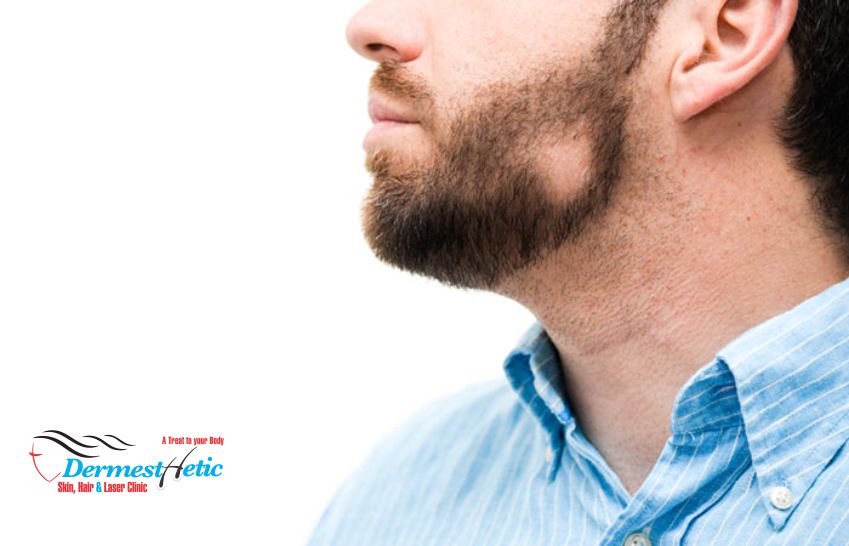
Alopecia areata is an autoimmune disease. Autoimmune means that the body’s immune system attacks the body. When alopecia areata develops, the body attacks its own hair follicles. A person’s genetic makeup, combined with other factors, triggers this form of hair loss. Medications and vitamins, Cancer chemotherapy, which attacks hair follicles in its attempt to kill all fast-growing cells around the body, is a well-known reason for hair loss. We at DERMESTHETIC Silakot & Lahore, Pakistan have experienced dermatologists and cosmetologists diagnosing and curing these diseases.
Conclusion
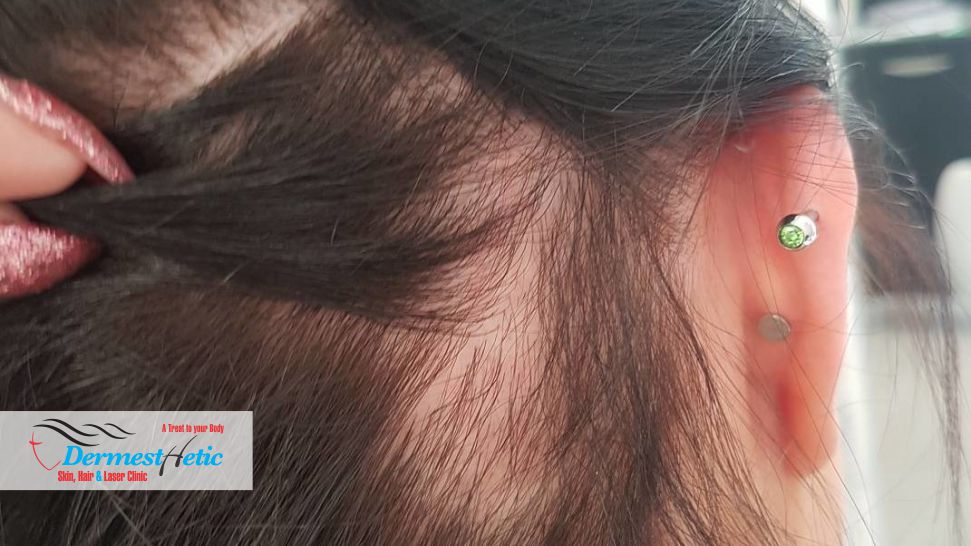
At DERMESTHETIC Silakot & Lahore, Pakistan we are committed to providing patients with the most advanced and authentic treatment of Alopecia in Pakistan. In order to educate our patients in great detail about Alopecia in general, it’s causes, it’s different types of Alopecia and various treatment options available in the world, we provide a detailed information in this portion that the patients can educate themselves in befitting manner regarding their disease. Before pursuing hair loss treatment, talk with your doctor about the cause of your hair loss and treatment options. If your doctor can’t confirm a diagnosis, he may send you to a lab for a test. They will scrape a small sample of skin from your scalp and look at it under a microscope. This can help them rule out other conditions that cause hair loss. You may also have a blood test to look for other autoimmune diseases.
Before starting treatment, a dermatologist should be consulted. We at DERMESTHETIC have such expertise and knowledge and you may meet with our doctors who are rated as the BEST SKIN SPECIALISTS AND DERMATOLOGISTS IN LAHORE, PAKISTAN with special expertise in skin diseases.
Causes
Alopecia areata is thought to be a systemic autoimmune disorder in which the body attacks its own anagen hair follicles and suppresses or stops hair growth. Psychological stress may result. People are generally otherwise healthy. In a few cases, all the hair on the scalp or all body hair is lost and loss can be permanent. Alopecia areata is not contagious. It occurs more frequently in people who have affected family members, suggesting heredity may be a factor. However, it most often occurs in people who have a family history of other autoimmune diseases, such as type 1 diabetes or rheumatoid arthritis. This is why some scientists suspect that genetics may contribute to the development of alopecia areata.
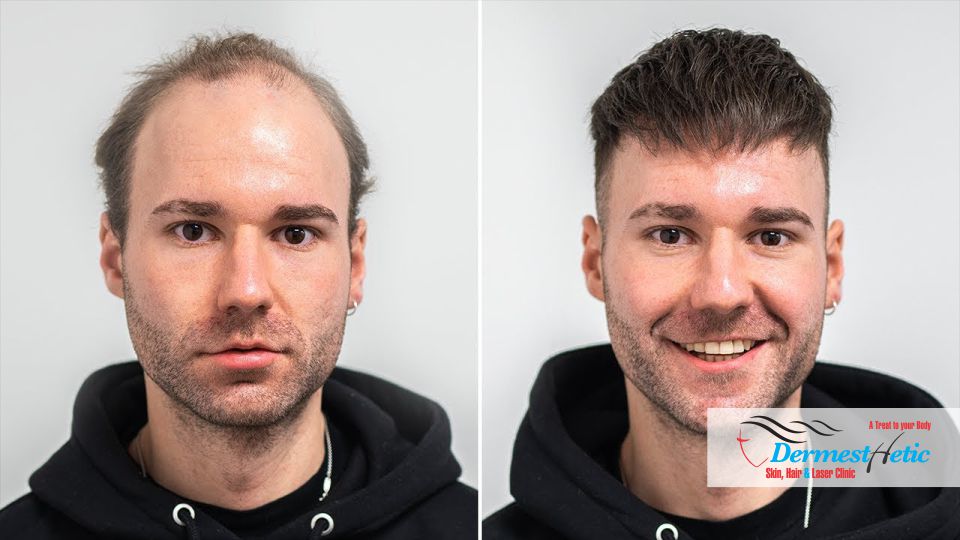
Symptoms
Researchers believe both genetics and environmental factors play a role. Common signs and symptoms include:
- Gradual thinning on top of head. This is the most common type of hair loss, affecting both men and women as they age.
- Circular or patchy bald spots.
- Sudden loosening of hair.
- Itching, burning or soreness
- Full-body hair loss.
- Patches of scaling that spread over the scalp.
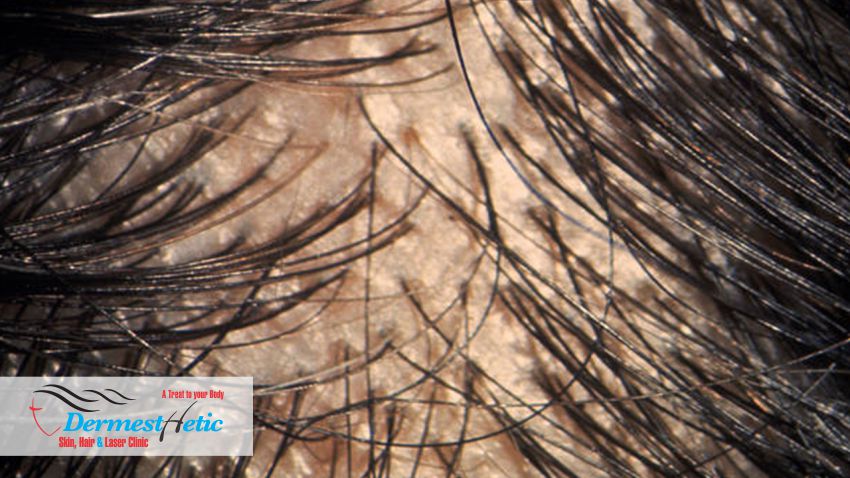
There’s currently no cure for alopecia areata. However, there are treatments that may help hair grow back more quickly and that can prevent future hair loss, as well as unique ways to cover up the hair loss. Resources are also available to help people cope with the stress of the disease. We at DERMESTHETIC at Silakot & Lahore, Pakistan have highly qualified Dermatologists/Cosmetologists who are expert in alopecia treatments and procedures. And don’t forget, waiting for alopecia to clear on its own can be frustrating. Without treatment, alopecia can cause low self-esteem, depression and anxiety.
Types of Alopecia
You may first notice clumps of hair on your pillow or in the shower. If the spots are on the back of your head, someone may bring it to your attention. However, other types of diseases can also cause hair to fall out in a similar pattern. Hair loss alone isn’t used to diagnose alopecia areata.
Types of Alopecia includes:
- alopecia totalis, which is the loss of all hair on the scalp
- alopecia universalis, which is the loss of all hair on the entire body
- Ophiasis, refers to hair loss in the shape of a wave at the circumference of the head.
- alopecia areata barbae, the disease may be limited only to the beard.
- diffuse alopecia areata, hair may also be lost more diffusely over the whole scalp,
- Alopecia areata monolocularis, describes baldness in only one spot. It may occur anywhere on the head.
- Alopecia areata multilocularis, refers to multiple areas of hair loss.
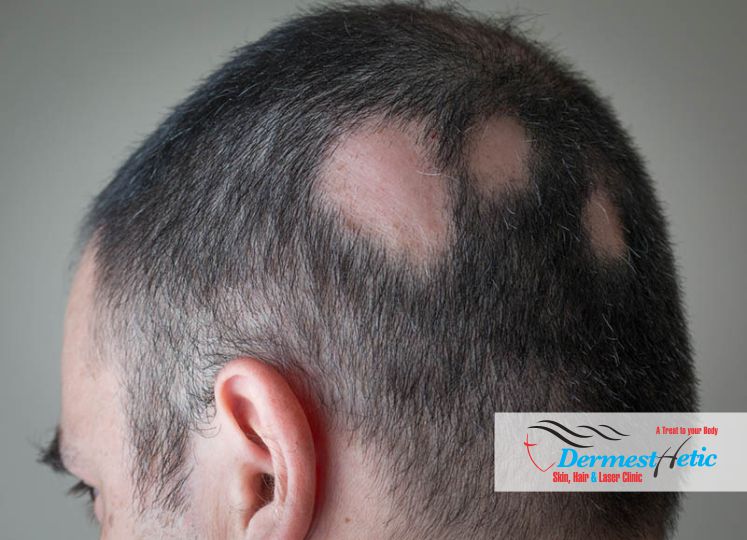
Doctors might avoid using the terms “totalis” and “universalis” because some people may experience something between the two. It’s possible to lose all hair on the arms, legs and scalp, but not the chest. For example, the hair loss associated with alopecia areata is unpredictable and as far as doctors and researchers can tell, appears to be spontaneous trusted source. The hair may grow back at any time and then may fall out again. The extent of hair loss and regrowth varies greatly from person to person.
Treatment
We at DERMESTHETIC at Silakot & Lahore, Pakistan have experienced dermatologists and cosmetologists treating the Alopecia and properly advise the patient regarding the treatment after making proper diagnosis. There is no cure for the alopecia. Efforts may be used to try to speed hair regrowth such as cortisone injections. Sunscreen, head coverings to protect from cold and sun and glasses if the eyelashes are missing is recommended. In some cases the hair regrows and the condition does not reoccur. In others hair loss and regrowth occurs over years. Among those in whom all body hair is lost less than 10% recover.
Alopecia areata can’t be cured. But it can be treated and hair can grow back. If you have it, there are several things to try:
- Topical Immunotherapy: This is used when there’s a lot of hair loss, or if it happens more than once. Chemicals are applied to the scalp to produce an allergic reaction. If it works, this reaction is actually what makes the hair grow back. It also causes an itchy rash, and usually has to be repeated several times to keep the new hair growth.
- Corticosteroids: These are anti-inflammatory drugs that are prescribed for autoimmune diseases. They can be given as an injection into the scalp or other areas. They can also be given in pill form or rubbed on the skin as an ointment, cream, or foam. The downside is that it may take a long time to work.
- Minoxidil (Rogaine): This treatment, which is put on the scalp, is already used for pattern baldness. It usually takes about 12 weeks before you see growth, and some users are disappointed in the results.
- Reduce stress: Personal troubles seem to trigger alopecia areata, although this has not been proven scientifically.
- Diet: When alopecia areata is associated with celiac disease, treatment with a gluten-free diet allows for complete and permanent regrowth of scalp and other body hair in many people, but in others there are remissions and recurrences. This improvement is probably due to the normalization of the immune response as a result of gluten withdrawal from the diet.
- Light Therapy: Light therapy is also called photochemotherapy or just phototherapy. It’s a type of radiation treatment that uses a combination of an oral medication called psoralens and UV light.
- Alternative Therapies: Some people with alopecia areata choose alternative therapies to treat the condition. These may include: aromatherapy, acupuncture, micro needling, probiotics, low-level laser therapy (LLLT), aloe vera drinks and topical gels, vitamins, like zinc and biotin, , onion juice rubbed onto the scalp, essential oils like tea tree, rosemary, lavender, and peppermint, other oils, like coconut, castor, olive, and jojoba, an “anti-inflammatory” diet, also called the “autoimmune protocol,” which is a restrictive diet that mainly includes meats and vegetables, scalp massage, herbal supplements, such as ginseng, green tea, Chinese hibiscus, and saw palmetto. Most alternative therapies haven’t been tested in clinical trials, so their effectiveness in treating hair loss isn’t known.
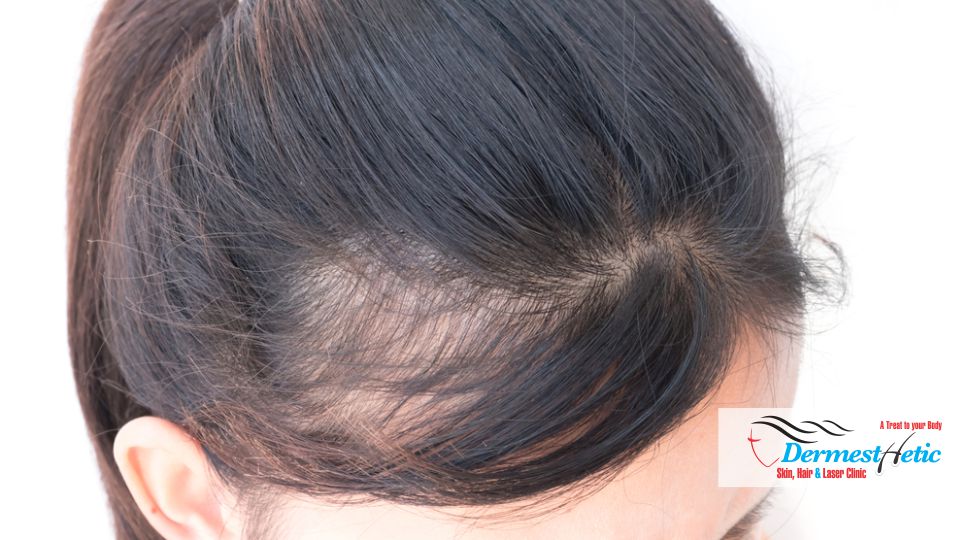
People with an autoimmune disease like alopecia areata are also more prone to having another autoimmune disease, including those that also affect the skin and hair like eczema, psoriasis etc. If you’ve been diagnosed with alopecia areata and another skin condition, you may find that treating one helps the other. In other cases, however, treating one may make the other worse.
Side effects
These medicines have possible side effects, so patients must be carefully monitored. A possible serious side effect of using of a topical corticosteroid for a year or longer is skin atrophy. This means the skin becomes paper thin, very dry, and fragile. External “triggers” like medication, injury, phototherapy may start a new bout of alopecia. These triggers aren’t the same for everyone. They may also change over time for you. The change in appearance caused by alopecia can affect a person’s emotional and psychological well-being. People can experience emotional stress, particularly if alopecia develops on visible areas of the body, such as the face or head.







